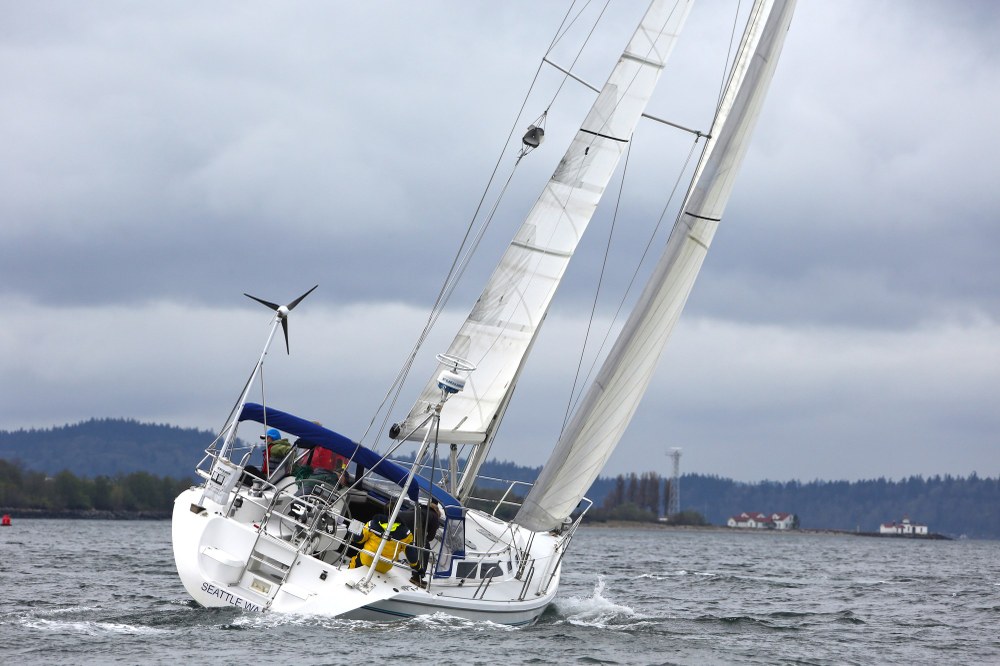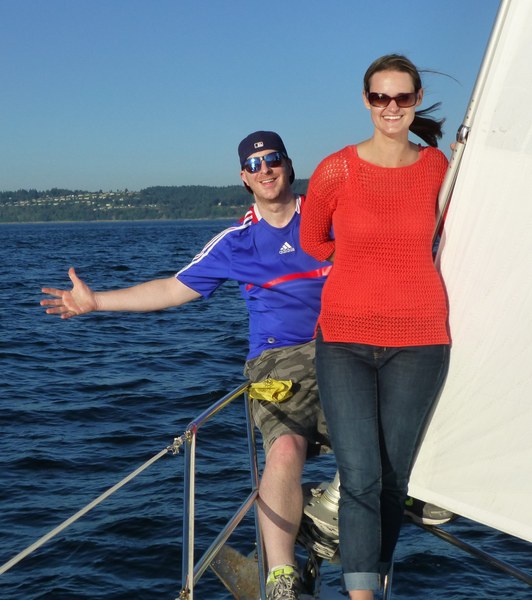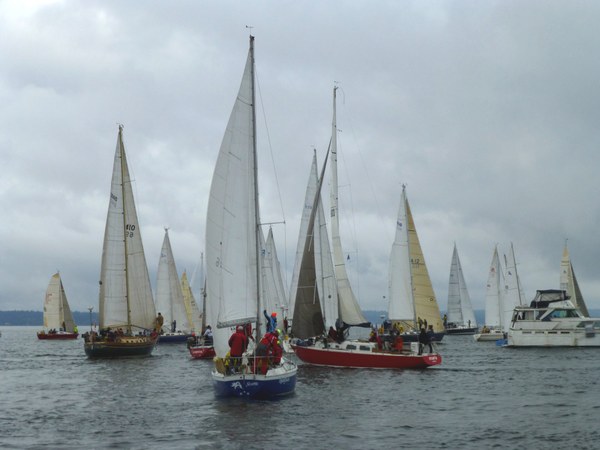
The wind was unreliable and moody that day. It was a typical Pacific Northwest early April morning: overcast and chilly but with a crisp tinge of salt in the air. My wife, Michelle, and I were at Shilshole Marina, just west of Seattle’s Ballard neighborhood, to take part in the Blakely Rock Benefit Race (sponsored by Sloop Tavern Yacht Club). We had both just finished the Mountaineers sailing class, but, here we were, about to partake in a major sailing event.
In May of 2014, Michelle and I moved to Seattle, from Northern Virginia and the metropolitan area of Washington D.C. Even though Virginia is a coastal state, we were not close to the Atlantic Ocean, Chesapeake Bay or any other large body of water. Sailing, to us, was only what we had seen on television or in films, or what we had read in books: a casual recreation activity for individuals who have the luxury of being close to water.
Seattle is a gorgeous city with an iconic skyline that touches the Puget Sound and frames majestic Mt. Rainier and the Cascades in the background. It’s hard to find a picture of Seattle without water. And naturally, with water, come boats. There are many marinas dotted in and around Seattle (Tacoma, Edmonds, Everett, Shilshole, Anacortes). My wife and I decided to join The Mountaineers with hopes of embracing the Pacific Northwest culture with an active, outdoor lifestyle. The Mountaineers is known for land-specific activities, such as hiking, skiing, and rock climbing. But there are water-specific activities too such as sea kayaking and, our favorite, sailing.
Days after finishing The Mountaineers sailing course, I received a request from the sailing committee chair and one of the skippers, Alan Vogt. He wanted to know if my wife and I wanted to be part of his crew for a race that was coming up in a couple days. It was the Blakely Rock Benefit Race and two of his crew had dropped out. He needed capable hands aboard. Knowing full well my limited sailing experience, I asked Alan if he was joking. He wasn’t. He said if we could follow directions and work hard, we’d be fine. Anxiousness, nervousness, skepticism and other immediate emotions washed over me, but ultimately, excitement prevailed. I said yes.
So here we were on a fluky, blustery and gray Saturday morning stepping onto the deck of Blue Fin at Shilshole Marina. There was an excitement in the air. Crews on board boats were getting their gear and boats ready for the day's race. After a long winter, you could tell there was an itch from skippers and crew alike. Everyone wanted to be out on the water again.
Blue Fin is a handsome 42-foot-long Catalina sailboat. It exudes swiftness, from its raked bow and flared hull to its slightly swept-back double spreaders. The transom tapers a bit which harbors a subtle and respectable design that makes it a rugged and efficient cruiser.
Aboard Blue Fin, Alan and his crew were getting the boat ready. Our crew consisted of me, Michelle, Kristina, Gary, and Alan the skipper. Kristina and Gary are both experienced deck hands and have crewed aboard Blue Fin on previous races.
BLUE FIN STANDS OUT AMONG THE OTHER SAILBOATS. PHOTO COURTESY OF ALAN VOGT.
Out on the water, boats were slicing through the choppy waves. It was a shifty start with winds blowing about 5-6 knots. Boats are classed according to their speed rating and sail plan. We were racing in a class with five other boats — boats with elegant names like Breeze and Tangent and Figaro. At the onset of the race, we fell into a respectable 3rd place. The first leg was upwind, tacking toward the rock.
Blakely Rock Benefit Race is named for the small and jagged island of rock that juts up and out the water only a couple hundred meters from Bainbridge Island. It’s the designated midpoint of the race. Boats jibe around Blakely Rock, then it’s a full-on sprint back to Shilshole. We tacked several times to stay with the boats in our group. The view of all the sailboats in the race was amazing; their spinnakers were up and full sails caught the wind just right. The gray skies had parted and the sun was starting to peek out. Seattle’s iconic downtown skyline is never more magnificent than when viewed from a boat on the Sound.
We made it to Blakely Rock and began our turn around, which is easier said than done. The exertion of grinding the sheets and working the winch compounded with adding line and trimming the sails every time we tacked was physically exhausting and mentally taxing. But the view of the fleet in the water was glorious! We had made it to Blakely Rock! All we had to do was sail back to the starting line. Everything was going smoothly.
Until we ran aground.
We were trying to undercut and get ahead of another boat but we hugged the coast of Blakely Rock just a bit too tight. Blue Fin’s keel hit the sand and we stopped dead in our tracks. After trying to move the wheel around and wriggling to no avail, I suggested to Alan that we put all our crew on the one side of the boat. Soon, with enough prodding and pulling, we were free. This whole snafu lasted maybe 5 or 6 minutes. But it was precious time as the other boats in the fleet made the jibe around the rock and started heading back. At this rate, we were going to be in the last place.
Looking around, the clouds were almost all gone and we had a gorgeous azure sky. It’s funny how the Pacific Northwest can turn from an overcast gray cloud-swept sky into a stunning and gorgeous afternoon in an instant. Most of the other boats were heading toward Elliot Bay. We tried to head that way but the wind just died. We were going 0 knots and the fleet was sailing away.
“OK we lost this race,” Alan said. Just then, a puff of wind back winded our jib and suddenly we were sailing in the opposite direction toward Bainbridge Island. Going in any direction is better than sitting with no wind. The wind started filling in and lifting us up parallel to the island. Alan said, “This is good, REALLY good.” As we got further and further away from the pack we noticed the rest of the fleet had sailed into a wind hole and were now drifting. We got a bit more wind and we kept sailing up the island. We finally hit the lay line, tacked over and raced for the finish line. We even had to dodge a ship on the way! We crossed the finish line and only saw a few boats milling about. We weren’t sure if we had won or lost. As we passed the committee boat and the gun went off, we realized, we WON! And by a large margin too! The other boats had not gotten out of the wind hole in time. We completed the race in just over 3 hours and 36 minutes, a good six minutes ahead of the next boat in our class, Breeze. We won the Championship trophy.
The Mountaineers' Sailing course teaches the basics of crewing a sailboat: how to rig a boat, trim sails, jibe and come about. It also teaches important safety lessons like how to rescue someone who has fallen overboard, how to wear a personal flotation device and how to monitor and call the Coast Guard. Now that my wife and I completed (and passed) the course, we can sign up and join any Mountaineers’ skipper for a race or a raft-up. That’s the joy of The Mountaineers: exploring and enjoying the outdoors — whether in the forest hiking, on a mountain snowshoeing, or on the water sailing. We're looking forward to many more sailing adventures.
 Ryan and Michelle Samples aboard Blue Fin. Photo by Alan Vogt.
Ryan and Michelle Samples aboard Blue Fin. Photo by Alan Vogt.
The Mountaineers Basic Sailing course includes four lectures, an “on the dock” session and two “on the water” sails. Once graduated, you qualify for free Mountaineers sail activities. Classes start this year on April 3 in Tacoma and April 4 in Seattle. Check out our upcoming courses.
This article originally appeared in our Spring 2017 issue of Mountaineer Magazine. To view the original article in magazine form and read more stories from our publication, click here.
This article originally appeared in our Spring 2017 issue of Mountaineer Magazine. To view the original article in magazine form and read more stories from our publication, click here.
 Ryan Samples
Ryan Samples
